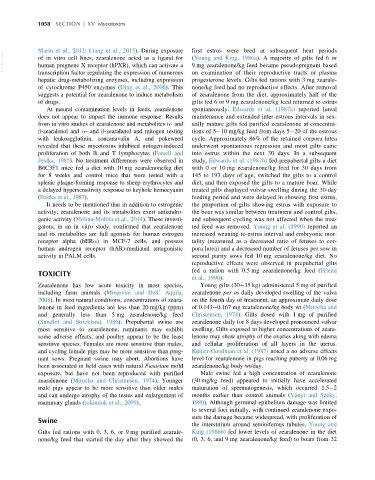Page 1126 - Veterinary Toxicology, Basic and Clinical Principles, 3rd Edition
P. 1126
1058 SECTION | XV Mycotoxins
VetBooks.ir Marin et al., 2013; Liang et al., 2015). During exposure first estrus were bred at subsequent heat periods
(Young and King, 1986a). A majority of gilts fed 6 or
of in vitro cell lines, zearalenone acted as a ligand for
9 mg zearalenone/kg feed became pseudopregnant based
human pregnene X receptor (hPXR), which can activate a
transcription factor regulating the expression of numerous on examination of their reproductive tracts or plasma
hepatic drug-metabolizing enzymes, including expression progesterone levels. Gilts fed rations with 3 mg zearale-
of cytochrome P450 enzymes (Ding et al., 2006). This none/kg feed had no reproductive effects. After removal
suggests a potential for zearalenone to induce metabolism of zearalenone from the diet, approximately half of the
of drugs. gilts fed 6 or 9 mg zearalenone/kg feed returned to estrus
At natural contamination levels in feeds, zearalenone spontaneously. Edwards et al. (1987a) reported luteal
does not appear to impact the immune response. Results maintenance and extended inter-estrous intervals in sex-
from in vitro studies of zearalenone and metabolites α-and ually mature gilts fed purified zearalenone at concentra-
β-zearalenol and α-and β-zearalanol and mitogen testing tions of 5 10 mg/kgfeedfromdays5 20 of the estrous
with leukoagglutinin, concanavalin A, and pokeweed cycle. Approximately 86% of the retained corpora lutea
revealed that these mycotoxins inhibited mitogen-induced underwent spontaneous regression and most gilts came
proliferation of both B and T lymphocytes (Forsell and into estrus within the next 30 days. In a subsequent
Pestka, 1985). No treatment differences were observed in study, Edwards et al. (1987b) fed prepubertal gilts a diet
B6C3F1 mice fed a diet with 10 mg zearalenone/kg diet with0or10 mgzearalenone/kgfeedfor30daysfrom
for 8 weeks and control mice that were tested with a 145 to 193 days of age, switched the gilts to a control
splenic plaque-forming response to sheep erythrocytes and diet, and then exposed the gilts to a mature boar. While
a delayed hypersensitivity response to keyhole hemocyanin treated gilts displayed vulvar swelling during the 30-day
(Pestka et al., 1987). feeding period and were delayed in showing first estrus,
It needs to be mentioned that in addition to estrogenic the proportion of gilts showing estrus with exposure to
activity, zearalenone and its metabolites exert antiandro- the boar was similar between treatment and control gilts,
genic activity (Molina-Molina et al., 2014). These investi- and subsequent cycling was not affected when the trea-
gators, in an in vitro study, confirmed that zearalenone ted feed was removed. Young et al. (1990) reported an
and its metabolites are full agonists for human estrogen increased weaning-to-estrus interval and embryonic mor-
receptor alpha (hERα) in MCF-7 cells, and possess tality (measured as a decreased ratio of fetuses to cor-
human androgen receptor (hAR)-mediated antagonistic pora lutea) and a decreased number of fetuses per sow in
activity in PALM cells. second parity sows fed 10 mg zearalenone/kg diet. No
reproductive effects were observed in prepubertal gilts
fed a ration with 0.5 mg zearalenone/kg feed (Friend
TOXICITY
et al., 1990).
Zearalenone has low acute toxicity in most species, Young gilts (30 35 kg) administered 5 mg of purified
including farm animals (Minervini and Dell’ Aquila, zearalenone per os daily developed swelling of the vulva
2008). In most natural conditions, concentrations of zeara- on the fourth day of treatment, an approximate daily dose
lenone in feed ingredients are less than 20 mg/kg (ppm) of 0.143 0.167 mg zearalenone/kg body wt (Mirocha and
and generally less than 5 mg zearalenone/kg feed Christensen, 1974). Gilts dosed with 1 mg of purified
(Sundlof and Strickland, 1986). Prepubertal swine are zearalenone daily for 8 days developed pronounced vulvar
most sensitive to zearalenone, ruminants may exhibit swelling. Gilts exposed to higher concentrations of zeara-
some adverse effects, and poultry appear to be the least lenone may show atrophy of the ovaries along with edema
sensitive species. Females are more sensitive than males, and cellular proliferation of all layers in the uterus.
and cycling female pigs may be more sensitive than preg- Kuiper-Goodman et al. (1987) noted a no adverse effects
nant sows. Pregnant swine may abort. Abortions have level for zearalenone in pigs reaching puberty at 0.06 mg
been associated in field cases with natural Fusarium mold zearalenone/kg body wt/day.
exposure, but have not been reproduced with purified Male swine fed a high concentration of zearalenone
zearalenone (Mirocha and Christensen, 1974). Younger (30 mg/kg feed) appeared to initially have accelerated
male pigs appear to be more sensitive than older males maturation of spermatogenesis, which occurred 1.5 2
and can undergo atrophy of the testes and enlargement of months earlier than control animals (Va ´nyi and Sze ´ky,
mammary glands (Jakimiuk et al., 2009). 1980). Although germinal epithelium damage was limited
to several foci initially, with continued zearalenone expo-
sure the damage became widespread, with proliferation of
Swine
the interstitium around seminiferous tubules. Young and
Gilts fed rations with 0, 3, 6, or 9 mg purified zearale- King (1986b) fed lower levels of zearalenone in the diet
none/kg feed that started the day after they showed the (0, 3, 6, and 9 mg zearalenone/kg feed) to boars from 32

